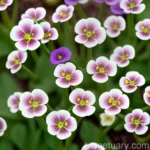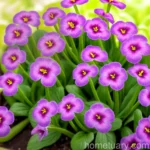The Wonderful World of Primrose (Primula x bulleesiana)
Welcome to the enchanting world of Primrose (Primula x bulleesiana)! This captivating plant species has been a beloved addition to gardens and landscapes for centuries, admired for its vibrant colors, delicate blooms, and ease of cultivation. In this comprehensive guide, we’ll delve into the diverse aspects of Primula x bulleesiana, from its cultural requirements to its propagation and maintenance. Whether you’re a seasoned gardener or a novice enthusiast, there’s something truly magical about the Primula x bulleesiana that is sure to captivate your green thumb and bring joy to your outdoor spaces.
What is Primrose (Primula x bulleesiana)?
Primula x bulleesiana, commonly known as the Bulleesiana Primrose, is a charming perennial plant that belongs to the Primulaceae family. This delightful hybrid is a result of crossing different Primula species, resulting in a plant that boasts stunning floral displays and a remarkable ability to thrive in various environments. Primrose plants are cherished for their unique characteristics and ability to brighten up gardens, borders, and woodland settings with their striking colors and early spring blooms.
Key Takeaways – Primula x bulleesiana
Before we embark on an exploration of the different facets of Primula x bulleesiana, here are some key takeaways to pique your interest:
- Scientific Name: Primula x bulleesiana
- Common Names: Bulleesiana Primrose, Primrose
- Plant Type: Perennial
- Family: Primulaceae
- Hardiness Zones: 3 to 8
- Bloom Time: Early to mid-spring
- Sunlight Requirements: Partial to full shade
- Watering Needs: Moist, well-draining soil
- Mature Height: 12 to 18 inches
- Colors: Vibrant hues of orange, apricot, and yellow
- Special Features: Deer-resistant, early blooming, attractive to pollinators
Now that we’ve introduced Primula x bulleesiana, let’s dive into the intricate details of its culture, uses, and care requirements.
Culture
Water
Primula x bulleesiana, like many Primula varieties, thrives in consistently moist soil. Adequate watering is essential to support healthy growth and prolific flowering. During periods of active growth and blooming, it’s crucial to ensure that the soil does not dry out completely. However, overwatering should be avoided, as waterlogged conditions can lead to root rot and other issues.
- Watering Tips:
- Provide regular, moderate watering, allowing the soil to dry slightly between waterings.
- Avoid overhead watering, as this can increase the risk of foliage diseases. Instead, water at the base of the plant to keep the leaves dry.
Sunlight
In terms of sunlight requirements, Primrose (Primula x bulleesiana) prefers partial to full shade. While it can tolerate some morning sun, especially in cooler climates, it generally thrives in areas with dappled sunlight or gentle shade. Excessive heat and direct afternoon sun should be avoided, as it can cause the delicate blooms to wilt prematurely.
- Sunlight Tips:
- Plant Primula x bulleesiana in locations where it receives filtered light or partial shade throughout the day.
- In hot climates, morning sun and afternoon shade provide an ideal balance for promoting healthy growth.
Fertilizer
When it comes to fertilizing Primula x bulleesiana, a light-handed approach is best. Excessive fertilization can lead to lush foliage at the expense of flower production, so it’s important to use a balanced, diluted fertilizer sparingly. Applying a slow-release, organic fertilizer in early spring can provide the necessary nutrients to support the plant’s growth and flowering.
- Fertilizer Tips:
- Use a balanced, water-soluble fertilizer at half the recommended strength every 4 to 6 weeks during the growing season.
- Avoid fertilizing Primula x bulleesiana during the dormant period, as this can disrupt its natural growth cycle.
Soil
Providing the right soil conditions is crucial for the health and vigor of Primula x bulleesiana. Well-draining, humus-rich soil that retains moisture without becoming waterlogged is ideal for this charming perennial. Additionally, a slightly acidic to neutral pH level is preferred by Primrose plants, ensuring that they have access to essential nutrients for robust growth.
- Soil Tips:
- Incorporate organic matter such as compost or well-rotted leaf mold into the soil to improve its texture and fertility.
- Mulch around Primula x bulleesiana to help maintain soil moisture and regulate temperature fluctuations.
Pruning
Pruning is an essential aspect of maintaining Primula x bulleesiana’s health and appearance. While deadheading spent blooms can encourage additional flowering, extensive pruning is generally not required for this species. However, removing any damaged or yellowing foliage can help prevent the spread of diseases and promote a tidy, attractive growth habit.
- Pruning Tips:
- Remove faded flowers promptly to promote prolonged blooming and prevent the plant from expending energy on seed production.
- Trim away any diseased or damaged leaves to maintain the overall vitality of the plant.
Propagation
Methods of Propagation
Propagating Primula x bulleesiana can be achieved through several methods, each offering its own unique benefits and challenges. Here are the primary propagation techniques used for this delightful plant:
-
Division: Dividing established clumps of Primula x bulleesiana in early spring or after flowering is a straightforward way to create new plants. Carefully separating the root mass into smaller sections ensures that each division receives sufficient roots and foliage to thrive independently.
-
Seed Propagation: Growing Primula x bulleesiana from seeds allows for the production of genetically diverse plants. Sow the seeds in a well-prepared seed-starting mix, keeping the trays or pots consistently moist and maintaining a mild, consistent temperature for germination.
Container Propagation
Primula x bulleesiana can be successfully propagated in containers, offering flexibility and convenience for gardeners with limited space or specific design preferences. Utilizing the same propagation methods as those in garden settings, container propagation allows for close monitoring of growing conditions and facilitates easy transplanting once the young plants have established strong root systems.
- Container Propagation Tips:
- Use well-draining, high-quality potting soil with added perlite or vermiculite for container propagation.
- Select containers with drainage holes to prevent waterlogged conditions and ensure aeration of the roots.
Popularity
In gardens and landscapes
Primula x bulleesiana has earned widespread popularity among gardeners and landscaping enthusiasts due to its exceptional visual appeal, reliability, and adaptability. Its gracefully nodding flowers in a captivating array of colors, including shades of orange, apricot, and yellow, make it a sought-after choice for adding a touch of early spring vibrancy to gardens, woodland areas, and shaded borders. The plant’s ability to naturalize in suitable environments further adds to its allure, creating stunning displays of naturalized growth over time.
In Floral Arrangements
Beyond its role in gardens and landscapes, the cut flowers of Primrose (Primula x bulleesiana) are prized for their ornamental value in floral arrangements. The delicate, cheerful blooms add a delightful touch to bouquets, centerpieces, and other floral compositions, bringing the essence of the spring garden indoors.
Common Diseases
Disease Diagnosis
Despite its overall resilience, Primula x bulleesiana is susceptible to certain diseases that can impact its growth and vigor. Being able to identify and diagnose these common diseases is essential for implementing effective preventive measures and treatments. Some of the prevalent diseases that may affect Primula x bulleesiana include:
-
Powdery Mildew: This fungal disease manifests as a powdery white coating on the leaves, stems, and flowers of the plant, often leading to stunted growth and reduced vigor. Overcrowding, poor air circulation, and high humidity contribute to the development of powdery mildew.
-
Botrytis Blight: Also known as gray mold, Botrytis blight presents as grayish brown spots on the foliage, often accompanied by fuzzy, gray mold. Prolonged periods of wet conditions and overcrowding can promote the spread of Botrytis blight in Primula x bulleesiana.
Prevention and Treatment
Implementing preventive measures is crucial for safeguarding Primula x bulleesiana against common diseases and preserving its vitality. Here are some strategies for preventing and treating diseases in Primrose plants:
-
Cultural Practices: Ensure proper spacing between plants to encourage air circulation and reduce humidity around the foliage. This helps minimize the risk of fungal diseases such as powdery mildew and Botrytis blight.
-
Sanitation: Promptly remove and dispose of any affected plant parts, including leaves and flowers showing signs of disease. Regularly clean and disinfect gardening tools and equipment to prevent the spread of pathogens.
-
Fungicidal Treatments: When necessary, apply an appropriate fungicidal spray to affected plants according to the manufacturer’s instructions. Fungicides can help manage and control fungal diseases that may impact Primula x bulleesiana.
Common Pests
Pest Identification
While Primula x bulleesiana is relatively resistant to many pests, certain insects and arachnids may pose a threat to its well-being. Being able to identify these common pests and understand their impact on the plant is essential for effective pest management. Some of the pests that may target Primula x bulleesiana include:
-
Aphids: These small, soft-bodied insects can congregate on the tender new growth and undersides of leaves, extracting sap and causing distortion of foliage.
-
Slugs and Snails: These mollusks are notorious for nibbling on the leaves of Primrose plants, leaving behind irregular holes and ragged edges as they feed.
Pest Control Measures
Implementing proactive pest control measures is essential for protecting Primula x bulleesiana from potential infestations and minimizing damage caused by common pests. Here are some effective strategies for managing pests on Primrose plants:
-
Natural Predators: Encourage the presence of natural predators such as ladybugs, lacewings, and predatory beetles, which feed on aphids and help keep their populations in check.
-
Physical Barriers: Use physical barriers such as copper tape or diatomaceous earth to deter slugs and snails from reaching Primula x bulleesiana. These barriers create abrasive or electrical shocks that discourage pests from feeding on the plants.
-
Horticultural Oils: Apply horticultural oils to suffocate soft-bodied pests like aphids, mealybugs, and spider mites, effectively controlling their populations without harming beneficial insects.
Botanist’s Tips
Enhancing Wildlife Habitat
Harness the innate beauty and allure of Primula x bulleesiana to create a welcoming habitat for pollinators and beneficial wildlife in your garden or landscape. By selecting a diverse range of Primula species and encouraging their naturalization, you can attract bees, butterflies, and hummingbirds, supporting essential pollination and adding dynamic movement to your outdoor spaces.
Companion Planting
Explore the art of companion planting to complement the elegance of Primula x bulleesiana with harmonious, supportive plant partners. Consider pairing Primrose plants with shade-loving companions such as Hellebores, Astilbes, and Ferns to create captivating woodland vignettes and enhance the visual appeal of shaded areas in your garden.
Fun Facts
As we continue our journey into the mesmerizing world of Primula x bulleesiana, here are some delightful fun facts about this captivating plant species:
- The word “Primula” is derived from the Latin word “primus,” which means “first,” reflecting the early spring bloom time of many Primula varieties.
- Primula x bulleesiana hybridizes readily with other Primula species, resulting in the creation of diverse cultivars and variations with unique traits and colors.
- In Victorian times, Primula flowers were treasured as symbols of young love and were often exchanged as tokens of affection and admiration.
Links to External Resources
To expand your knowledge and further your exploration of Primula x bulleesiana and related topics, consider diving into the following external resources:
- The Plantsman’s Corner: Primula x bulleesiana
- Royal Horticultural Society: Primroses
- [University of Illinois Extension: Growing P















